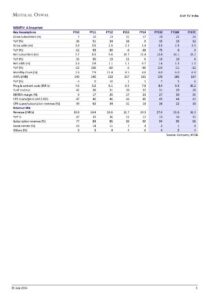Content
This Business Builder will guide you through a step-by-step process to create a profit and loss statement for your business. Sales return From the seller’s point of view, merchandise https://kelleysbookkeeping.com/ returned by a buyer for any of a variety of reasons; to the buyer, a purchase return. Income from operations Gross margin – Operating (selling and administrative) expenses.
Sales discount is reported on the income statement to offset a company’s gross sales, which in turn results in a smaller net sales figure. As a contra revenue account, a sales discount has a debit balance that reduces gross sales revenue which has a credit balance on an income statement. Contra revenue accounts are expected to have a debit balance that is contrary to the normal credit balance of revenue.
Sales Returns
However, if items are packaged together for one price and cannot be broken out and purchased separately, you must collect tax on the total price. Sales Returns and Allowances and Sales Discounts are Are Sales Discounts Reported As An Expense? contra-revenue accounts. The creation of a profit and loss statement is an important event for a small business. At one glance, it provides a summary of the most important activities of the company.
- With the use of a contra-revenue account, the reader of the income statement will be able to differentiate between the original amount of sales revenue generated, the sales reduction, and the resulting net amount.
- Sales return From the seller’s point of view, merchandise returned by a buyer for any of a variety of reasons; to the buyer, a purchase return.
- Another example is “2% 10/Net 30” terms, which means that a buyer will enjoy a 2% discount if he settles his balance within 10 days of the invoice date, or pays the full price in 30 days.
- In order to record this transaction, Company ABC’s Cash account would be debited by the amount of $98 cash received from the customer and the Sales discount account would be debited by the amount of $2 discount.
Despite their similarities, discounts received and discount allowed are not one and the same thing. The primary difference between the two lies in the role of your company as a discount provider or as a recipient. Selling Expense – Expenses related to order taking and product sales.Back to main document. If you are a manufacturer, complete the separate Cost of Goods Manufactured Worksheet to make sure all applicable costs are accounted for. Transfer your costs of goods manufactured to the general worksheet and continue using the general worksheet to calculate the net income for your operation. This Business Builder will explain, through a step-by-step process and the use of a worksheet, how to create a P & L statement.
Accounting 101: Deferred Revenue and Expenses
This entry will recognize the sale amount $25k as well as recognizing the account receivable amount $25K in the income statement. The recognition of the sales is at gross before cash discount since the customer does not make the payment yet. Sales or Cash Discounts are properly recorded and shown in the financial statements. Most businesses do not offer early payment discounts, so there is no need to create an allowance for sales discounts. Sales discounts are recorded as a reduction in revenue under the line item called accounts receivable.

In accounting, the terms “sales” and “revenue” can be, and often are, used interchangeably to mean the same thing. It is important to note that revenue does not necessarily mean cash received. A portion of sales revenue may be paid in cash and a portion may be paid on credit, through such means as accounts receivables. The income statement is the financial report that is primarily used when analyzing a company’s revenues, revenue growth, and operational expenses.
Which of these is most important for your financial advisor to have?
The income statement is broken out into three parts which support analysis of direct costs, indirect costs, and capital costs. The direct costs portion of the income statement is where net sales can be found. As seen, the sales discount is a contra-revenue account that appears as a $10 reduction from the gross revenue of $1000 that the manufacturer reported, resulting in net revenue of $990. This means that the sales discount that was issued during the accounting period cost the business $500. However, in accounting a sales discount is not treated as an expense account but as a contra-revenue account. This article aims to answer the question ‘is sales discount an expense?
The net income represents the excess of income over expenses incurred to generate the revenues. Net sales is usually the total amount of revenue reported by a company on its income statement, which means that all forms of sales and related deductions are combined into one line item. Gross sales should be shown in a separate line item than net sales as there can be substantial deductions from gross sales. If this deduction is hidden on a financial statement, the statement will be missing key information about the quality of sales transactions. Sales Discounts account A contra revenue account to Sales; it is shown as a deduction from gross sales in the income statement.
All three costs generally must be expensed after a company books revenue. As such, each of these types of costs will need to be accounted for across a company’s financial reporting in order to ensure proper performance analysis. There are two primary types of discounts in accounting that might occur in your small business – trade discounts and cash discounts. A trade discount occurs when you reduce your sales price for a wholesale customer, such as on a bulk order. This type of discount does not appear in your accounting records or on your financial statements specifically.

Gross revenue is before contra-revenue accounts like allowance for sales returns, bad debt expense, any potential sales discounts, etc. Gross revenue is reduced to net revenue after accounting for all of the previously discussed contra-revenue accounts. A seller will debit a sales discounts contra-account to revenue and credit assets. The journal entry then lowers the gross revenue on the income statement by the amount of the discount. Credit the sales revenue account by the same amount in the same journal entry. For example, assume your small business sold $100 in products to a customer who will pay the invoice at a later date.
FOB destination Means free on board at destination; goods are shipped to their destination without charge to the buyer; the seller is responsible for paying the freight charges. Cost of goods available for sale Equal to beginning inventory plus net cost of purchases. If so, understand how discounts help—or hurt—your small business’s net revenue. The above are the entries and the calculation of the sales discount. As you can see, full amounts of cash are received and the full amount of account receivables are discharged from the company account. A manufacturer sells $1000 worth of products to its customer with credit terms of 1/10, n/30.

Subtract the total sales discounts from the gross sales revenue you earned in the period before accounting for discounts. Report your result as “Net sales” below the sales discounts line on your income statement. The amount of net sales is the actual revenue you earned after accounting for discounts. Using the previous example, assume you had $20,000 in gross revenue during the period. As seen in the income statement report above, the sales discount as a contra revenue account appears as a $1,500 reduction from the gross revenue of $30,000 that Jenny’s organics recorded. As seen in the income statement above, the sales discount is a contra-revenue account and not an expense.

Average Rating